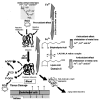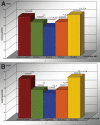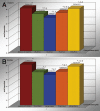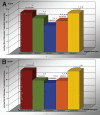Redox homeostasis of albumin in relation to alpha-lipoic acid and dihydrolipoic acid
- PMID: 20716945
- PMCID: PMC2952079
- DOI: 10.4161/oxim.3.3.11786
Redox homeostasis of albumin in relation to alpha-lipoic acid and dihydrolipoic acid
Abstract
Albumin represents the predominant circulating antioxidant agent in plasma exposed to continuous oxidative stress and a change in serum albumin structure accounts for its antioxidant properties. Alterations in the redox status of albumin may result in impairments of its biological properties. Alpha-lipoic acid (LA), a naturally occurring thiol compound found in virtually all species, is a potent antioxidant with high efficacy which is also involved in the chelation of metal ions, regeneration of antioxidants, and repair of oxidatively damaged proteins. In human body LA is rapidly reduced to dihydrolipoic acid (DHLA) after intake into the cell. Both, LA and DHLA are amphipathic molecules which act as antioxidants both in hydrophilic and lipophilic environments. The present study aimed to investigate the antioxidant/pro-oxidant effects of LA and DHLA due to their concentrations in metal-catalyzed protein oxidation (MCO) of human serum albumin (HSA). Progressive oxidative modification of albumin was found in MCO system by an increased content of protein hydroperoxides (POOH), protein carbonyl groups (PCO) which is the former's major breakdown product, and other protein oxidation markers such as advanced oxidized protein products (AOPP) and protein thiol groups (P-SH). The possible antioxidant protective effects of LA and DHLA were observed with 25 microM and 50 microM; DHLA being more influential. Protein oxidation parameters were found to be lower and P-SH levels seemed higher. However, prooxidant effects of both LA and DHLA came on the scene with increased concentrations of 75 microM and 100 microM where the latter seemed the most hazardous with contradicted results. It is clear that the loss of biological activity of human serum albumin by MCO system appears of medical relevance and if LA exerts similar effects seen in the present study, it is possible that cellular prooxidant activity can also result consuming this unique antioxidant in certain doses.
Figures






Similar articles
-
[Alpha-lipoic--dihydrolipoic acids--active bioantioxidant and bioregulatory system].Ukr Biokhim Zh (1999). 2005 May-Jun;77(3):20-6. Ukr Biokhim Zh (1999). 2005. PMID: 16566124 Review. Russian.
-
The pharmacology of the antioxidant lipoic acid.Gen Pharmacol. 1997 Sep;29(3):315-31. doi: 10.1016/s0306-3623(96)00474-0. Gen Pharmacol. 1997. PMID: 9378235 Review.
-
Lipoic and dihydrolipoic acids as antioxidants. A critical evaluation.Free Radic Res. 1994 Feb;20(2):119-33. doi: 10.3109/10715769409147509. Free Radic Res. 1994. PMID: 7516789
-
Pro-oxidant actions of alpha-lipoic acid and dihydrolipoic acid.Med Hypotheses. 2006;66(1):110-7. doi: 10.1016/j.mehy.2005.07.020. Epub 2005 Sep 13. Med Hypotheses. 2006. PMID: 16165311
-
Thiol chelation of Cu2+ by dihydrolipoic acid prevents human low density lipoprotein peroxidation.Free Radic Biol Med. 1998 Aug;25(3):287-97. doi: 10.1016/s0891-5849(98)00048-3. Free Radic Biol Med. 1998. PMID: 9680174
Cited by
-
Assessing the effects of tempol on renal fibrosis, inflammation, and oxidative stress in a high-salt diet combined with 5/6 nephrectomy rat model: utilizing oxidized albumin as a biomarker.BMC Nephrol. 2024 Feb 23;25(1):64. doi: 10.1186/s12882-024-03495-0. BMC Nephrol. 2024. PMID: 38395806 Free PMC article.
-
Lipoic acid antagonizes paraquat-induced vascular endothelial dysfunction by suppressing mitochondrial reactive oxidative stress.Toxicol Res (Camb). 2019 Sep 27;8(6):918-927. doi: 10.1039/c9tx00186g. eCollection 2019 Nov 1. Toxicol Res (Camb). 2019. PMID: 32774841 Free PMC article.
-
Biomolecular Modulation of Neurodegenerative Events during Ageing.Oxid Med Cell Longev. 2015;2015:978654. doi: 10.1155/2015/978654. Epub 2015 Oct 25. Oxid Med Cell Longev. 2015. Retraction in: Oxid Med Cell Longev. 2019 Oct 15;2019:3571916. doi: 10.1155/2019/3571916. PMID: 26583065 Free PMC article. Retracted.
-
Free radicals and antioxidant status in protein energy malnutrition.Int J Pediatr. 2014;2014:254396. doi: 10.1155/2014/254396. Epub 2014 Mar 27. Int J Pediatr. 2014. PMID: 24790610 Free PMC article.
-
Exogenous and endogenous antioxidants in osteoporosis risk: causal associations unveiled by Mendelian Randomization analysis.Front Physiol. 2024 May 31;15:1411148. doi: 10.3389/fphys.2024.1411148. eCollection 2024. Front Physiol. 2024. PMID: 38883185 Free PMC article.
References
-
- Çakatay U, Aydın S, Yanar K, Uzun H. Gender-dependent variations in systemic biomarkers of protein, DNA, and lipid damage in aged rats. Aging Male. 2010;13:51–58. - PubMed
-
- Çakatay U, Kayalı R, Uzun H. Relation of protein oxidation parameters and paraoxonase activity in the ageing population. Clin Exp Med. 2008;8:51–57. - PubMed
-
- Roche M, Rondeau P, Singh NR, Tarnus E, Bourdon E. The antioxidant properties of serum albumin. FEBS Lett. 2008;582:1783–1787. - PubMed
-
- Kawakami A, Kubota K, Yamada N, Tagami U, Takehana K, Sonaka I, et al. Identification and characterization of oxidized human serum albumin. FEBS Journal. 2006;273:3346–3357. - PubMed
MeSH terms
Substances
LinkOut - more resources
Full Text Sources

